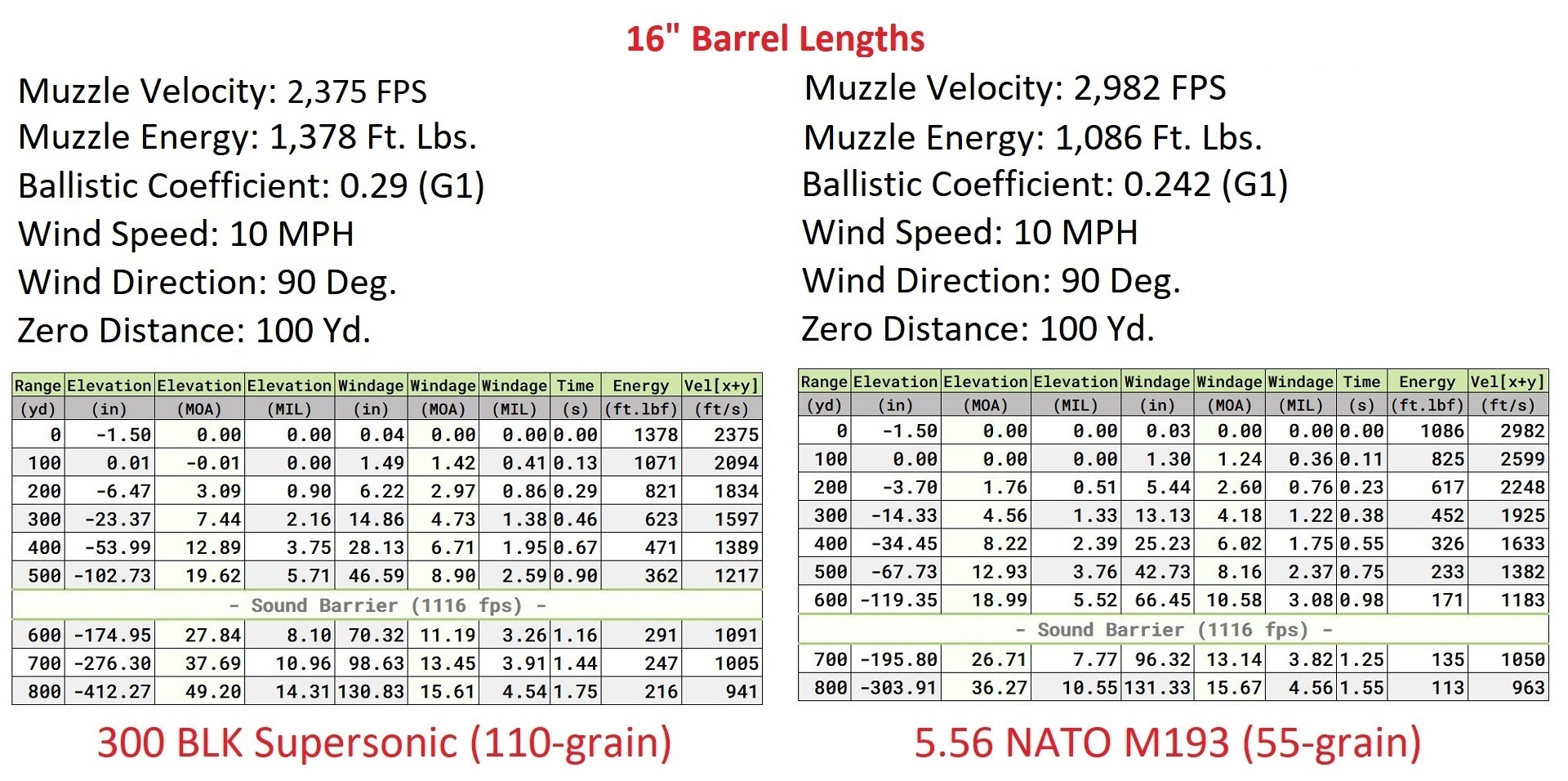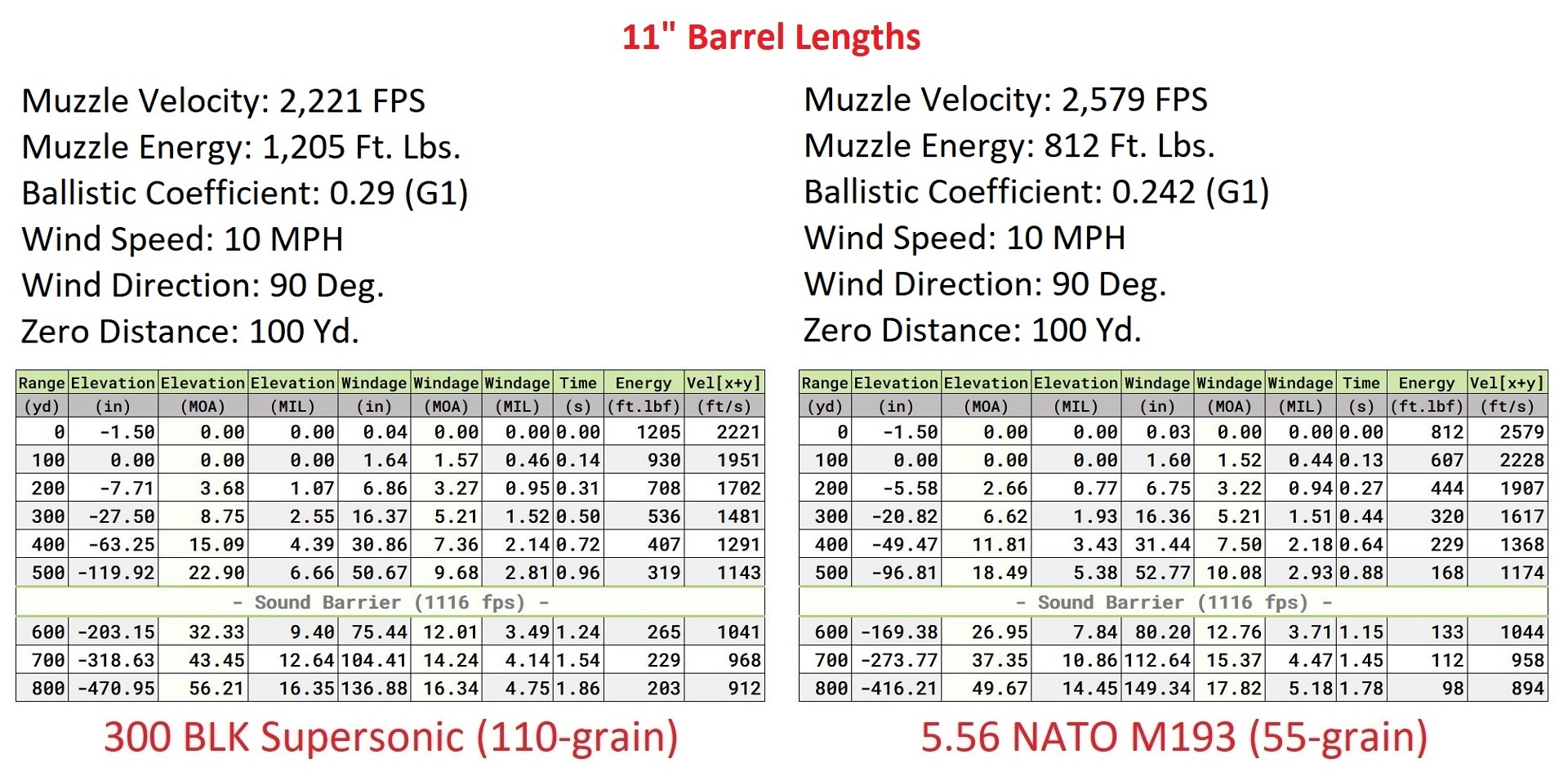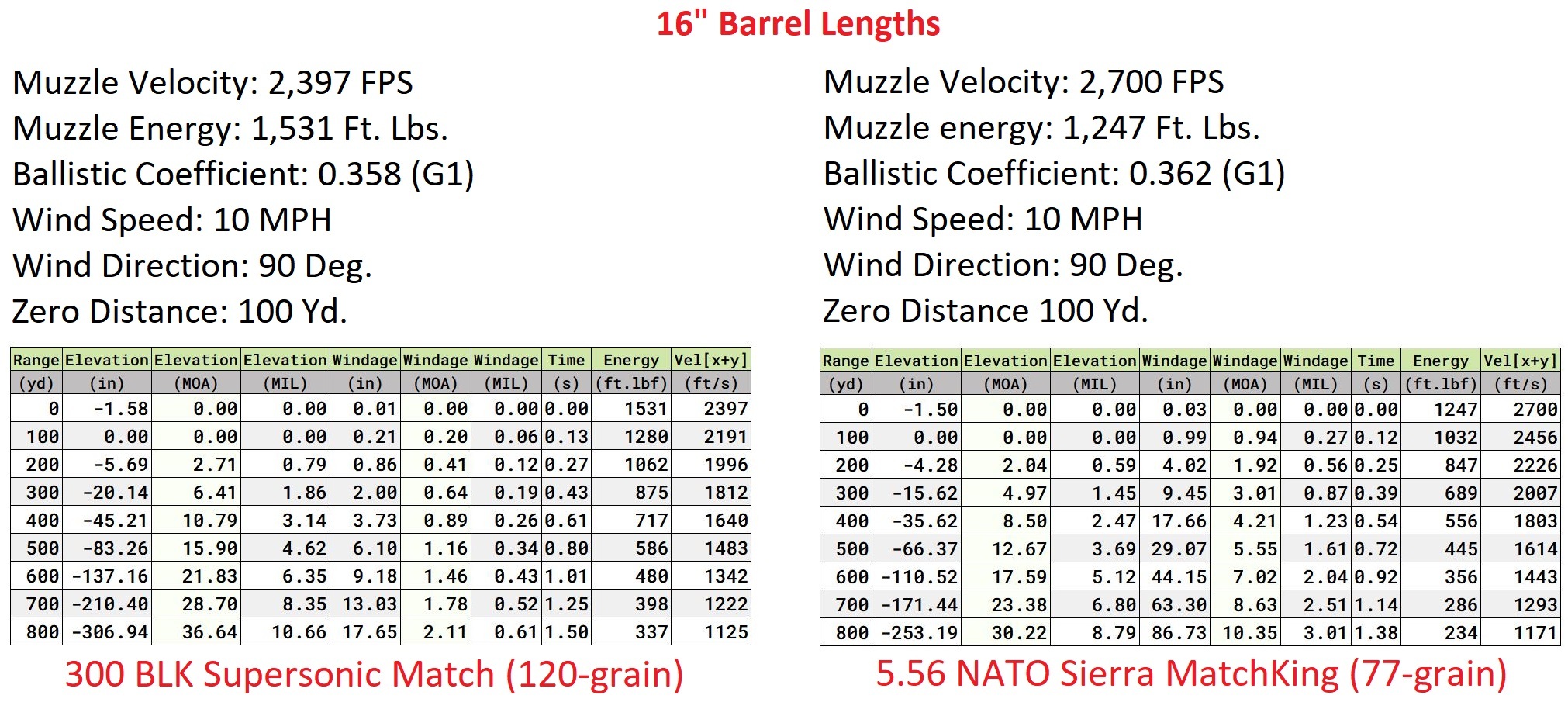Why 300 BLK is Better Than 5.56 NATO (With Ballistics Data)
Posted by gunbuilders.com on Jun 11th 2025
It's true: 300 AAC Blackout is, in fact, almost universally superior to 5.56 NATO and .223 Remington. We've got the ballistics data to prove it, too. There's just one, specific circumstance in which 5.56 or .223 is "slightly better", which we'll cover below.
So, if you're on the fence about which caliber to chamber in your AR-15, let's help you decide.
What is 300 Blackout?
300 BLK, which is officially called the .300 AAC Blackout, or 7.62x35mm cartridge, is a .308-caliber bullet fixed to a chopped down 5.56 NATO casing. The cartridge was developed in the mid-2000s for special operations forces.
The idea behind 300 BLK was to provide special operators with a round that offered higher performance than 5.56 NATO (especially in short-barreled rifles, which operators almost exclusively use) while also providing better sound suppression by offering both supersonic and subsonic loads.
Just as important, 300 BLK does not require extensive modification to the existing AR-15 to function.
Both subsonic and supersonic rounds can be chambered in any AR-15, whether newly assembled or previously chambered in 5.56 NATO or .223 Remington, with only a barrel change.
Beyond the need for a new barrel, 300 BLK makes use of all the AR's existing components, including the upper and lower receivers, the bolt carrier group and fire controls, the gas tube and block, and the buffer assembly.
Why 300 BLK is Better Than 5.56 NATO (and .223)
5.56 NATO and .223 Remington are old. While still the most popular AR-15 cartridges, these rounds are starting to show their age with their performance, especially compared to other modern rifle cartridges.
Standard 5.56 and .223 loads (we're talking about 55- and 62-grain, by far the most common loads) suffer from having low ballistic coefficients, which means they lose velocity and energy relatively quickly as they travel downrange, and they suffer from low hit probabilities at distance.
To compensate for this rapid loss of velocity and power, these rounds need to be fired from long barrels. A 16" barrel is considered the minimum length for achieving good performance at 300 yards and beyond, while a 20" barrel (the barrel length originally chosen by AR-15 designer Eugene Stoner) is needed to truly maximize performance.
300 BLK Offers Better Performance Than Standard 5.56/.223 Loads in 16" Barrels
Let's get into the hard data. First, let's bust the myth that 300 Blackout is only a short-barreled rifle round. It is, in fact, superior to common 55-grain and 62-grain 5.56 and .223 loads when fired from a 16"-barreled rifle.

When 110-grain 300 BLK and 55-grain 5.56 NATO are both fired from 16" barrels, we find that 300 BLK offers 21% more muzzle energy. When both barrels are zeroed at 100 yards, 300 BLK's bullet drop is only marginally greater at all practical shooting distances.
At 200 yards, 300 BLK drops 6.5" and 5.56 drops 3.7". At 300 yards, 300 BLK drops 23.4" and 5.56 drops 14.3". Only at 500 yards does the difference become significant, with 300 BLK dropping 102.7" while 5.56 drops 67.7".
Importantly, although 5.56 drops less, 300 BLK retains far more energy as it travels downrange. That difference in energy retention also grows as distance increases. By the time both rounds reach 500 yards, 300 BLK retains 362 ft.-lbs. of energy on impact, while 5.56 retains just 171 ft.-lbs. That's about 50% less energy.
300 BLK also offers superior ballistic coefficients, translating into better hit probability than 5.56. The 110-grain load above has a G1 ballistic coefficient, while 55-grain 5.56 NATO has a G1 BC of 0.242. The higher BC of 300 Blackout allows for greater statistical accuracy -- in other words, 300 BLK's point of impact is more likely to match your point of aim with each shot, especially in adverse conditions.
300 BLK is Far Superior to 5.56/.223 in Short Barrels
It's in the short-barreled rifle that 300 Blackout truly shines when compared to 5.56 NATO:

When both rounds are fired from 11" barrels, 110-grain 300 BLK offers an even more significant advantage in energy retention than 55-grain 5.56 NATO, and the differences in bullet drop between the two cartridges become almost negligible.
At the muzzle, 300 BLK offers 33% more muzzle energy, with bullet drop that's just 19% greater at 500 yards. And, once again, 300 BLK retains approximately 50% more energy at that same distance.
It's also important to note that in reducing barrel length from 16" to 11", 300 BLK only loses 6.5% of its muzzle velocity. But 5.56 NATO loses nearly 14% of its velocity, and this difference in muzzle velocity begins to increase substantially when both rounds are chambered in even shorter barrels.
300 Blackout can, in fact, be chambered in a barrel as short as 8.5" and still obtain near-nominal muzzle velocity (about 2,200 FPS). But 5.56 NATO only produces a muzzle velocity of approximately 2,300 FPS in a barrel this short; that's a reduction from its nominal velocity of nearly 23%.
"But Match 5.56 and .223 is Better! ... Right?"
That's only half true. Some heavy, match-grade 5.56 NATO and .223 Remington loads might perform better than 300 Blackout, in certain rifle configurations. But the differences aren't as significant as you may think, and there are costs to consider.
Let's compare 77-grain Sierra MatchKing 5.56 NATO to 148-grain Super Match 300 Blackout when both rounds are fired from 16" barrels:

Going back to 16" barrels, we find in our ballistic data that even when 5.56 NATO is chambering Sierra MatchKing, it fails to beat 300 Blackout when it comes to takedown power and energy retention downrange. When 300 BLK chambers its own match ammo (120-grain Tac-TX), it offers 19% more muzzle velocity, and its energy retention remains 24% greater than 5.56 NATO at 500 yards.
Bullet drop is also not a significant concern for 300 Blackout in this comparison. At 500 yards, it drops just 21% more than 5.56 NATO, and the difference in drop between these two rounds remains insignificant between 200 and 400 yards when both barrels are zeroed at 100 yards.
Remember, this comparison is made using 16" barrels. Were we to perform the same comparison in using shorter barrels, 5.56 NATO would again suffer a bigger disadvantage 300 BLK, because due to its powder, it would suffer from a greater comparative loss in muzzle velocity.
The only argument one make in favor of 5.56 NATO, here, is that the 77-grain Sierra MatchKing offers a slightly higher ballistic coefficient. But the argument's weak, because the difference is negligble. The SMK's BC value is just 0.004 points greater than the 300 BLK's 120-grain Tac-TX.
So, Why Chamber 5.56 Over 300 BLK?
There is still plenty of good reason to chamber 5.56 NATO instead of 300 Blackout. For starters, it's a more affordable and accessible cartridge. Standard 55- and 62-grain 5.56 and .223 rounds can be found for as little as $0.23 to $0.25 per round. Supersonic 300 Blackout, however, typically costs at least $0.40 to $0.50 per round, while even common subsonic loads can cost well over $1.00 per round, and match-grade subsonics can demand $1.50 to $2.00 per round.
There is also the argument to be made that having less bullet drop is more favorable than having more energy on impact, particularly when target shooting. There's simply no need to strike steel or paper targets "harder," while compensating for less drop makes hitting your targets slightly easier.
Why 300 Blackout is Still Better, Overall
With these two arguments -- cost and bullet drop -- in favor of 5.56 and .223 aside: The 300 Blackout round, whether supersonic or subsonic, is superior to 5.56 and .223 when it comes to power, energy retention downrange, ballistic coefficients when comparing typical commercial loads, performance in short-barreled setups, and performance when firing suppressed.
(Want to Build a 300 BLK AR, Now?)
We've got you covered. We have quality 16"-barreled 300 BLK rifle kits designed to maximize supersonic performance, and we have the short-barreled option for building a pistol or SBR with subsonic performance in mind.
DISCLAIMER: If you are new to the world of DIY gun building, you likely have a lot of questions and rightfully so. It’s an area that has a lot of questions that, without the correct answers, could have some serious implications. At GunBuilders.com, we are by no means providing this content on our website to serve as legal advice or legal counsel. We encourage each and every builder to perform their own research around their respective State laws as well as educating themselves on the Federal laws. When performing your own research, please be sure that you are getting your information from a reliable source.

